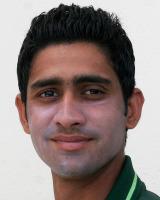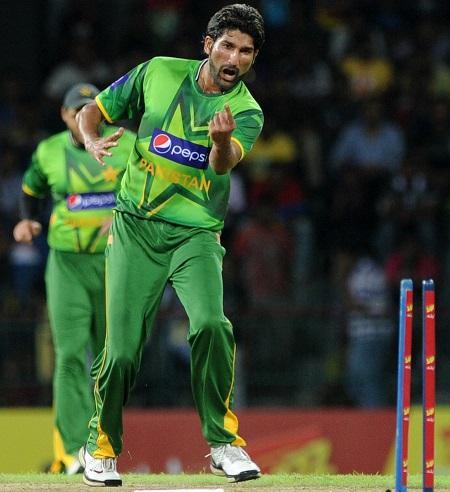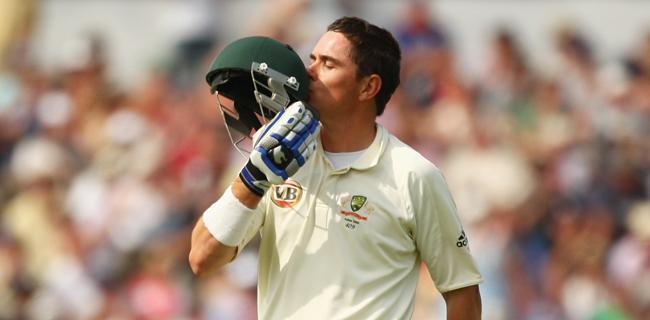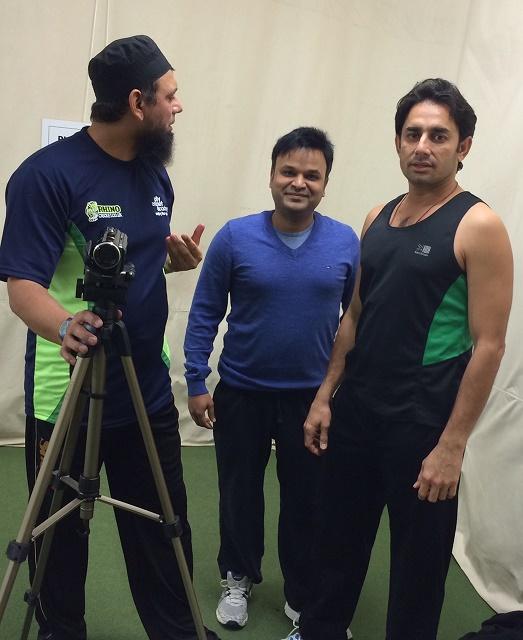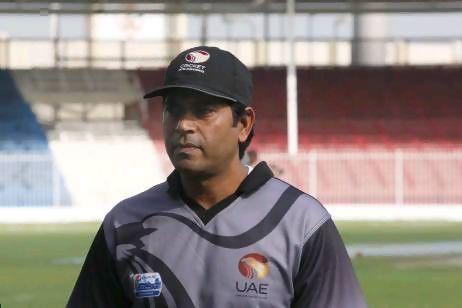PakPassion.net presents an exclusive interview with world's finest batmaker, James Laver. James is head batmaker at Laver&Wood since 1999 and before Laver&Wood James worked at Millichamp & Hall. Over the period of time James made his name in cricket bats field by making impressive bats for likes of Steve Waugh, Brain Lara and many many more. Below is the interview PakPassion.Net did with James Laver.

by Saj Sadiq (11th June 2011)
PakPassion.net: Is bat making a dying art?
James Laver: I think it is a huge shame that a lot less bats can now be called ?hand-made?. Unfortunately big business demands large profit margins and it is cheaper for many big companies to make bats in different manners. Having said that there are some absolutely superb bat-makers around doing their thing so I think that the art of the pod shaver will never disappear.
PakPassion.net: What is the most unusual request for a modification in a bat you were asked for?
James Laver: Aside from profiles, handles seem to be the part of the bat that customers are most ?fussy? about. We have many requests for different shapes, different materials, very specific grip set-ups etc. Recently we have had quite a few people asking about counter-balances as a few pro players have started using them.
I guess the most recent, very strange request came from a customer here in New Zealand who wanted a copy of the old Lance Cairns Newbery Excalibur. He insisted on it being the same shape and dimensions as well as the weight being identical to what Lance used to use ? 3lbs 5ozs. I simply cannot understand how someone can use it effectively ? but each to their own!
Another bat I have made is one the full 38? long for a player in the UK who had a bad back and could not bend. I can?t think of too many other reasons for using a bat this long though as it slows down your bat speed considerably.
PakPassion.net: Are bats made lighter by shaving wood off or a lighter wood is used?
James Laver: To answer your question ? both techniques are used. I will certainly use a lighter original cleft for a bat that is to be finished at 2lbs 7ozs than one that is to be finished at 3lbs.
However it is not always as simple as starting off with a very light cleft. For a very light bat I will also have to take wood out of certain areas to make sure the finished weight is accurate. Making sure a bat performs well at a lightweight is one of the most difficult aspects of the job but one that challenges and motivates me.
PakPassion.net: Are grains really that important on a bat?
James Laver: It depends exactly what you refer to as important. In terms of performance ? not really. Many of our best performing bats come from willow graded by our merchants as Grade 2 and therefore do not have perfectly straight and even grains.
Essentially it comes down to the fact that tightly grained bats (12 or more) perform better initially but do not last as long. Bats with what we refer to as the optimum number (7 to 10) last much longer. This is important for our bats as they are known to continually improve over time.
Obviously, the longer a bat lasts, the more opportunity it has to develop. Therefore tightly grained clefts may perform well to begin with but after half a season or so bats with fewer grains will begin to out-perform them.
PakPassion.net: Do pressed bats last less than bats knocked in with a mallet?
James Laver: As far as I?m aware nearly every single bat made by a skilled bat-maker is pressed prior to being crafted.
If you are referring to being pressed once finished as opposed to being knocked in by a mallet then we certainly recommend using a mallet. We always recommend doing something by hand rather than using a machine as human interaction with a natural product is incredibly important. If you knock in a bat by hand you can make sure you spend more time on the important areas (toe and edges) than the sweet spot. The toes and the edges are the areas most prone to breakage and therefore need to be knocked in to a greater extent.
PakPassion.net: Who in your opinion makes the best bats (apart from Laver & Wood).
James Laver: There are many great bat-makers around the world but having trained under him, I can say that Julian Millichamp does make some very special bats.
Having seen some of Tim Keeley?s work along with a few of the smaller bat-makers in the UK I think the general standard out there is very high.
I have also seen some beautiful bats coming out of the large manufactures in India and Pakistan ? the ability of some of the bat-makers there is excellent.
PakPassion.net: You've made bats for some fine players, who was the picky one of the lot?
James Laver: One of the pickiest was certainly Sanath Jayasuriya. I made a bat for him in 1998, which lasted him roughly four hours and 200 runs! Ever since then he was insistent on making every bat I made for him as close as possible to that specific one. It was difficult at times to get the bats identical but I enjoyed the challenge
PakPassion.net: Which bat in world cricket impresses you the most? One that you haven't personally made?
James Laver: At the moment I am really impressed by the GM Flare profile. It seems to allow for a large hitting zone whilst also retaining good balance and pick-up.
PakPassion.net: What's your opinion on the Mongoose cricket bat?
James Laver: I think that the ?Mongoose? style bat certainly has a place in world cricket. It is all about making the hitting zone as powerful as possible so that you can consistently clear the boundary. I have made quite a few similar ones in the past and think they all stem back to the Newbery Excalibur used by Lance Cairns in the 70s and 80s.
PakPassion.net: Have you ever made a bat for Sachin Tendulkar?
James Laver: Unfortunately due to sponsorship agreements I cannot say which current players I have made bats for/am currently making bats for. It is safe to say that I have made bats for a lot of the best cricketers in the world over the past 20 years ? take from that what you will!
PakPassion.net: Any new innovations in bat making like the Mongoose MMi3? A bat specially made for T20 cricket?
James Laver: We are always on our toes looking at new ways to make bats that hit the ball even further. There are so many different aspects to bat making that there is always room for trial and improvement. I am hugely dedicated to experimenting and trying new things so keep an eye out on our website's special offers page- as there are likely to be some prototypes on there in the near future.
PakPassion.net: Which type of bat do you gain most satisfaction from producing - a large heavy bat or smaller lightweight? Which one is easier to produce?
James Laver: Making every single bat is a challenge and therefore satisfaction comes with every single one that leaves the workshop. The challenge of making a light bat that performs well is matched by the challenge of ensuring a heavy bat is balanced well and picks up nicely.
Overall though lights bat takes more time to produce and is trickier. This is down to the fact that you need to be very careful where you take the wood from so that the balance and performance is kept superb.
PakPassion.net: What are your views on the heavy bats cricketers use nowadays?
James Laver: Cricketers are always looking for ways to hit the ball harder and further. Many have decided that heavy bats are the way to do this whereas some think that bat-speed is more important and therefore want lighter bats.
Essentially it comes down to the fact that each player has their own preferences and will stick with what suits them. My personal prediction is that as time goes on I think we will begin to see fewer players using ultra-light bats (2lbs 6ozs or under) as well as few players going for extra-heavy ones (2lbs 14ozs or more). I believe most of the best bats out there are in the 2lbs 9ozs to 2lbs 13ozs range.
PakPassion.net: When you are pressing a bat, what role does adding or removing moisture play in creating / enhancing ping?
James Laver: This is a very complex question that could take hours to answer! I?ll give it my best shot at keeping it simple!
We try and keep the moisture content of our bats at around 12% as this is a good balance between performance and durability. To an extent, the ?drier? a bat, the better it will perform and the ?wetter? a bat, the longer it will last. That is a huge generalization but it is important to note.
If a willow cleft is dried to below the 10% moisture level then it will obviously weigh less than one at 12%. Therefore you will get a larger bat for the weight. This will increase performance. The less obvious way low moisture content improves performance is down to how ?full? of water the willow cells are.
The best analogy I can come up with here is a balloon. If it is full of air and you push the side with your finger there is little indenting and therefore little rebound. However, if it is only half full of air then there is more indenting and therefore more energy comes back towards your finger in returning the balloon to its original shape.
I really hope that makes sense!
PakPassion.net: Is the 'ping' of the bat a result of the cleft itself or pressing?
James Laver: It is a combination of both. You will never get a top-performing bat out of a bad piece of willow but bad pressing can also turn a good piece of willow into a plank. Both aspects are incredibly important to the quality of a finished bat.
PakPassion.net: Do you press your clefts before or after you cut them to size (4 1/2 inch face, toe etc)
James Laver: We cut the cleft to width before pressing but then cut the bat to length afterwards.
PakPassion.net: How did you learn your secrets to pressing a bat? How long did it take you to learn?
James Laver: I learnt the pressing processes I use over many years and in some ways I am still learning now. I have used many different presses in many different ways and it took a good few years before I got to the stage where I am perfectly happy with my technique.
PakPassion.net: What scientific testing do you perform on clefts? What advancements have been made in cleft selection? What advancements have been made in cultivation of English Willow? Any ideas regarding GM for enhanced qualities?
James Laver: I have a few specific tests that I do on the clefts at various stages of the bat-making process to check their performance and structural integrity but I would prefer not to go into too much detail.
In terms of the cultivation and selection of willow I really leave that to the guys at JS Wright & Sons as this is what they do best. There is a reason that they are the biggest and best willow merchants in the world and I leave it all down to them. I am lucky that they have always been good to me with the willow that I buy!
PakPassion.net: What are the causes of low-density clefts?
James Laver: Low density is simply a natural property of certain willow trees. It comes down to the conditions in which the specific willow tree grew (weather, sunlight etc) as well as how quickly it developed.
Once again, the actual willow merchants would be much more qualified to discuss this than myself.
PakPassion.net: What is your opinion of heartwood in clefts?
James Laver: Genuinely, the tests that I have done have shown that there is only a very marginal difference between heartwood and sapwood. Therefore whether a bat is all sapwood, all heartwood or half and half tends not to influence my selection too much. Some people do have preferences though and so I would of course look at those when selecting.
PakPassion.net: What is your opinion of high density / low density cleft bats? Which is preferred and why?
James Laver: It is simple enough to say that as long as low-density clefts are structurally sound then they are preferential. A low-density cleft is lighter than a high-density one and will therefore produce a larger bat at a given weight.
PakPassion.net: What role does CAD / CNC play in bat manufacturing in the future?
James Laver: I think more and more CNC machines will make bats in the future. The demand for cricket bats the world over means that not all bats can be made by hand. I am confident though that many companies will stick with the handcrafting process as it certainly leads to more consistent top quality bats.
PakPassion.net: What is your opinion on handles? What handles do you use in your bats (which type of cane) how many pieces? What do you make the rubber from?
James Laver: Our handles are made from Manau / Sarawak cane with rubber inserts and some are assembled in India and some here depending on the supply of cane. The rubber sheets are made in India. The handles mostly have 4 pieces but some we do use multi laminates for.
We also conduct quite a large amount of R&D into handles and have been known to use some of our own designs when we decide they are good enough!
PakPassion.net: How does this affect the performance of a bat? Do you use lighter and heavier handles?
James Laver: Handles are very important when looking at the performance of a bat. Not only are low quality handles prone to breakage but they can also lead to a loss of power by vibrating too much. The more a handle vibrates the more energy is lost and therefore less goes back out through the face of the bat. The handles also do vary a lot in weight and so we do make sure that the right one is matched to the right blade.
PakPassion.net: Do you play catch up with bat design? Or are you the one leading the way with bowing in the face and sculpting of the back and the trend towards larger shoulders and smaller spines?
James Laver: I like to think that the effort we put into trialing new designs and processes means that we are one of the most forward thinking companies out there. Having said that, we are certainly interested in other companies? products due to the fact that improving our products and ourselves constantly motivates us.
PakPassion.net: Should you get your bat pressed or rolled after purchase as "recommended" by some retail outlets? How would this affect performance?
James Laver: We always recommend preparing your bat before use. This only needs to involve knocking in and using the bat against softer, older balls prior to introducing it to a brand new cricket ball. More information on knocking in can be found here;
http://www.pakpassion.net/ppforum/sh...d.php?t=115787
Generally I am not a fan of rolling the bat after it has been made as it is very easy to destroy the performance. The force the press putt on the face of the bat is much harder to control after it has been made.
PakPassion.net: What on earth makes your bats special apart from the fact that they are "traditionally" made and that they have "selected" willow like every other L.E bat?
James Laver: I?m not going to say that every bat I make is better than any other bat available out there. What I can say is, due to the fact we look extensively at your game and work out what specifications would suit you best, in the vast majority of cases we will produce one of the best suited bats you will ever use. 9 times out of 10 a bat that is custom made for you from top quality English Willow will suit you better than a bat purchased ?off the rack?.
PakPassion.net: Making adjustments for different batsmen i.e. getting the balance correct, does that affect the power delivered from certain parts of the bat?
James Laver: We discuss this with the vast majority of our customers. We find out what is more important to them ? balance, performance etc ? and produce the bat to match what they?re looking for. If balance is the absolute most important aspect then the performance in certain areas may not be quite as good as with a bat designed purely for top performance.
PakPassion.net: I prefer an oval handle to a round one, are there any other variations in the handles dept.??
James Laver: Pretty much every handle can be classed as oval, round or a mixture. The majority of handles we produce are oval or semi-oval. I don?t think a triangular or square handle would really work!
PakPassion.net: Where do you obtain the willow and which is the finest source in your experience?
James Laver:
Related Posts
